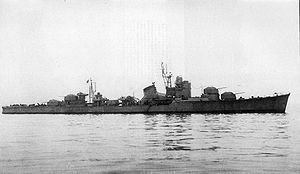Name Harutsuki Completed 28 December 1944 Construction started 23 December 1943 Length 134 m | Laid down 23 December 1943 Struck 5 October 1945 Launched 3 August 1944 | |
 | ||
Commissioned 28 December 1944, 11th Destroyer Squadron Fate Transferred to the Soviet Union, 28 August 1947 | ||
Harutsuki (春月) was an Akizuki-class destroyer of the Imperial Japanese Navy. Her name means "Spring Moon". She was different from her other sisters, as she was built as a flagship for the Escort Fleet.
Contents
Design and description
The Akizuki-class ships were originally designed as anti-aircraft escorts for carrier battle groups, but were modified with torpedo tubes and depth charges to meet the need for more general-purpose destroyer. Her crew numbered 300 officers and enlisted men. The ships measured 134.2 meters (440 ft 3 in) overall, with a beam of 11.6 meters (38 ft 1 in) and a draft of 4.15 meters (13 ft 7 in). They displaced 2,744 metric tons (2,701 long tons) at standard load and 3,759 metric tons (3,700 long tons) at deep load.
The ship had two Kampon geared steam turbines, each driving one propeller shaft, using steam provided by three Kampon water-tube boilers. The turbines were rated at a total of 52,000 indicated horsepower (39,000 kW) for a designed speed of 33 knots (61 km/h; 38 mph). The ship carried up to 1,097 long tons (1,115 t) of fuel oil which gave them a range of 8,300 nautical miles (15,400 km; 9,600 mi) at a speed of 18 knots (33 km/h; 21 mph).
The main armament of the Akizuki class consisted of eight Type 98 100-millimeter (3.9 in) dual purpose guns in four twin-gun turrets, two superfiring pairs fore and aft of the superstructure. They carried four Type 96 25-millimeter (1.0 in) anti-aircraft guns in two twin-gun mounts. The ships were also armed with four 610-millimeter (24.0 in) torpedo tubes in a single quadruple traversing mount; one reload was carried for each tube. Their anti-submarine weapons comprised six depth charge throwers for which 72 depth charges were carried.
Construction and career
On 5 October 1945, Harutsuki was removed from Navy List. On 28 August 1947, she was turned over to the Soviet Union, renamed Vnezapny (Внезапный) and rearmed with eight 102-millimeter (4 in) guns, fifteen 25 mm guns and four 533-millimeter (21 in) torpedo tubes. She became the training ship Oskol in 1949, target ship TSL-64 in 1955 and finally floating barracks PKZ-37, scrapped in 1969.
